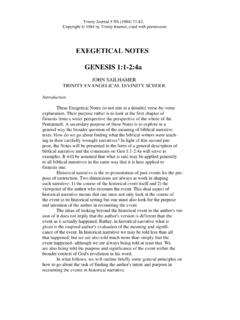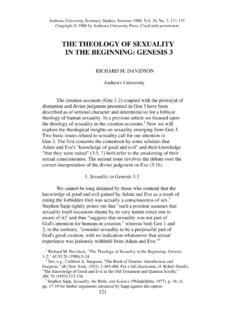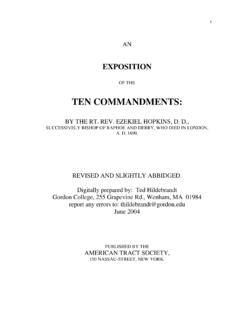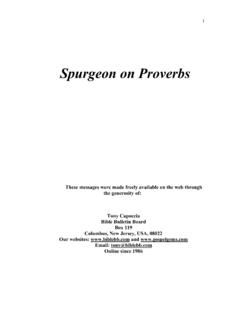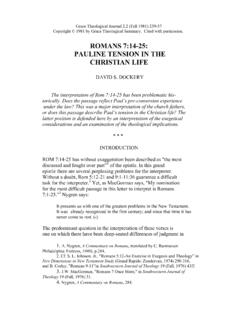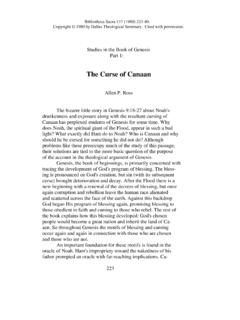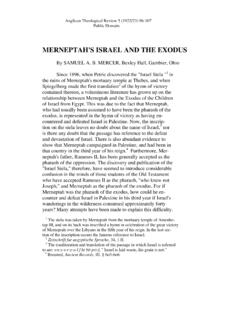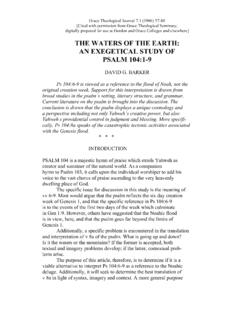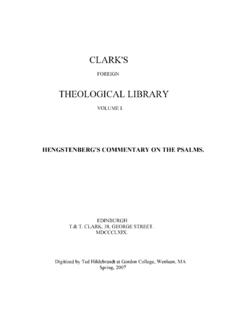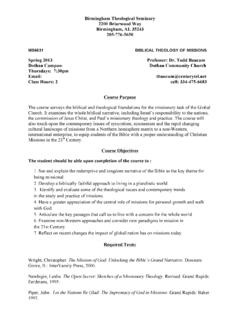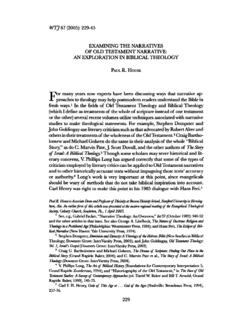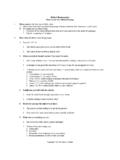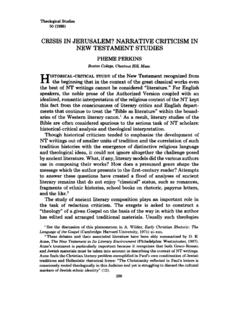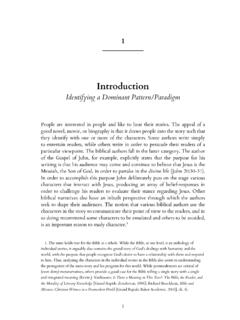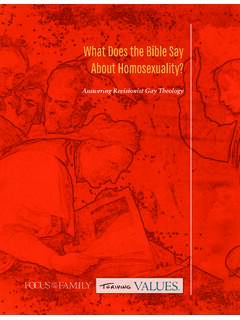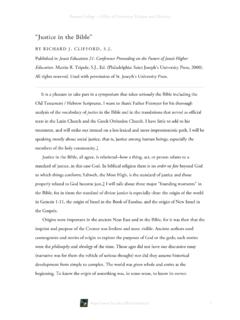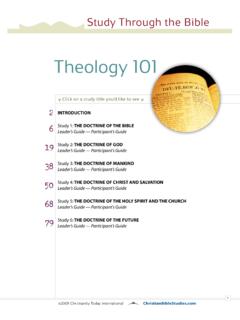Transcription of The Coherence of Exodus: Narrative Unity and …
1 Calvin Theological Journal 36 (2001): 251-269 Copyright 2001 by Calvin Theological Seminary. Cited with permission. The Coherence of ExoduslNarrative Unity and Meaning Arie C. Leder Until the rise of modern criticism, studies of the Pentateuch focused on problems in the reading and understanding of the received text Although incoherence in the biblical text had been noted before, it was the serious devel- opment of the historically oriented critical methodologies in the eighteenth century and beyond that gave birth and support to a consistent skepticism about the historical, literary, and theological Unity of this part of the Christian Scriptures. Enthralled by the inelegance of the pentateuchal text, criticism's identification of the four underlying, primary sources of the Pentateuch left no doubt about the incoherence of the received text. Nevertheless, the critical approaches also suggested the means for recovering a coherent message: Disentangle the primary sources from the secondary accretions, identify their historical and social location, and let these recovered primary sources speak.
2 Furthermore, by analyzing the relationship of the secondary and later editor- ial additions to the identified earliest level of the text, scholars argued that it was not only possible to recover the compositional process of the text but also to understand the interplay of the different ideological positions represented by the sources and the various additions. Thus, by identifying the composi- tional history of the received text, locating the underlying primary sources within their sociopolitical and religious contexts, and understanding the inter- play of the various layers, the historical critical methodologies sought to explain the contradictions they identified and to support scientifically the continuing meaningfulness of the received biblical text. The individual books of the Pentateuch, however, disappeared from view, including from the textbooks that introduced theology students to the Pentateuch because they were redistributed among the underlying sources.
3 Literary-critical excavation of the so-called primary documents of the Pentateuch also reshaped pentateuchal theology and the studies of personages of the Old 1 This article completes the study of exodus begun in Calvin Theological Journal 34 (1999): 11-35. 2 See, for example, Robert H. Pfeiffer (Introduction to the Old Testament [New York: Harper & Brothers, 1941], 129-292) who, although he acknowledges that the Pentateuch "is a single work in five volumes and not a collection of five different books" (129), studies the Pentateuch in terms of 251 CALVIN THEOLOGICAL JOURNAL 252 Although the critical students of the Pentateuch held to the incoherence of the received text, they held firmly to the Coherence of the primary sources--to the point of distinguishing clearly among the linguistic gifts and peculiar the- ologies of their Historical-critical studies, it was thought, would yield a fuller comprehension of the text by integrating the results of these studies into an understanding of the received text.
4 In some sense, then, a coherent understanding of this ancient literature was the ultimate goal. Nevertheless, the academy's failure to integrate the results of historical critical exegesis into a fuller understanding of the received text would leave Scripture fragmented and, to a large extent, silent in the "documents." Otto Eissfeldt (The Old Testament: An Introduction, trans. Peter R Ackroyd [New York: Harper and Row, 1965], 194-211) studies its " Narrative strands." Similarly, see Ernst Sellin and George Fohrer, Introduction to the Old Testament, trans. David E. Green (Nashville: Abingdon, 1968), 103-92, and Artur Weiser, The Old Testament and Its Deveiopment (New York: Association Press, 1963), 70-142. Contemporary introductions continue in this vein. See Norman K Gottwald (The Hebrew Bible: A Socio-Literary Introduction [Philadelphia: Fortress, 1985], 135-48), who introduces his readers to The Great Traditionists of Ancient Israel," and Anthony R Ceresko, Introduction to the Old Testament: A Liberationist Perspective (Maryknoll: Orbis, 1992), 52-71.
5 This approach has also influenced the study of OT personalities; see Rudolf Kittel, Great Men and Movements in Israel (New York: KTAV Publishing, 1968), 175-99 and his review of the "Great Narrators." F1eming, James (Personalities of the Old Testament [New York: Charles Scribner's, 1951], 196-209, 282-99, 425-42) treats 'The Yahwist," "The "Deuteronomists," and "The Priestly Writers." For a brief description of the characteristics of the primary sources, see Raymond B. Dillard and Tremper Longman III, An Introduction to the Old Testament (Grand Rapids: Zondervan, 1994), 40-42. For an extended discus- sion, see Antony F. Campbell and Mark A O'Brien, Sources of the Pentateuch: Texts, Introductions, Annotations (Minneapolis: Fortress, 1993). 3 See, for example, Walter Brueggemann and Hans Walter Wolff, The Vitality of Old Testamen Traditions (Atlanta: John Knox, 1975); the discussion in R. N. Whybray, The Making of the Pentateuch:A Methodological Study (Sheffield, 1987), 47-48; and F1eming James' enthusiastic description of the Yahwist (Personalities of the Old Testament, 196): "About me time when Elijah and Elisha were doing their work in the northern kingdom there lived in the kingdom of Judah a remarkable man, who, though his name is nowhere mentioned in the Bible, stands out today as one of the supreme thinkers of ancient Israel.
6 This man is a discovery of modern scholarship.. He was in all probability a single personality. Many scholars, it is true, find two or more strands of Narrative .. But the J Narrative taken as whole is so vivid and colourful, so fresh and full of power, that we can hardly go far wrong in believing it to be the work of single great mind." 4 See for example, James D. Smart, The Strange Silence of the Bible in the Church: A Study in Hermeneutics (Philadelphia: Westminster, 1970). Whether such integration would have been possible is another matter, as James A. Wharton indicated (See below, footnote 5). The academy's separation of the Bible from the church continues in its contemporary claims that the interpretation of biblical documents has no validity beyond "the assent of various interest groups." Such interest groups may, of course, include the church, but typically the reference is to groups determined by ethnic, cultural, gender, or sexual-orientation interests.
7 David J. A Clines, for example, writes: there are no 'right' interpretations, and no validity in interpretation beyond the assent of various interest groups, biblical interpreters have to give up the goal of determinate and universally acceptable interpretations, and devote themselves to producing interpretations they can sell-in whatever mode is called for by the communities they choose to serve. This is what I call 'customized' interpretation." In his "A World Established on Water (Psalm 24) ," in The New Literary Criticism and the Hebrew Bible, ed. David Clines and Cheryl J. Exum. (Sheffield: JSOT, 1993), 87. THE Coherence OF exodus 253 In 1974, Brevard S. Childs addressed this failure in his critical theological commentary on In it he argued that the critical methodologies should, and attempted to show how they could, contribute to an understand- ing of the canonical text.
8 Thus, while he acknowledged the importance of his- torical critical exegesis, he required this exegesis to enlighten the received, canonical text. And, when he declared the commentary's purpose to be theo- logical and "directed toward the community of faith which lives by its confes- sion of Jesus Christ,"6 he acknowledged and argued that the present shape of exodus , although a composite Narrative , was the text to be explained, not the reconstructed sources, traditions, or forms. Although Childs did not argue for the Coherence of the received Narrative , by subordinating critical exegesis to the received shape of the text, he acknowledged the significance and influence of the canonical text. Recent introductions have begun to refer again to the tra- ditional division of the Pentateuch7 and, in conjunction with the emergence of the new literary approach,8 studies have defended the received shape of the individual books of the Pentateuch and of the Pentateuch Since the eighteenth century, biblical studies have moved from under- standing Coherence and meaning as located in the world behind the text, in which historical, critical, and compositional issues were crucial, to the world of the text itself, where historical and compositional issues are less, and literary concerns more, important.
9 Some exegetes, however, ignore both of these, sometimes 5 Brevard S. Childs, The Book of exodus : A Critical; Theological Commentary (Philadelphia: Westminster, 1974). Indicative of the response to this publication is James A Wharton's critical, yet sympathetic, review, "Splendid Failure or F1awed Success?" Interpretation 29 (1975): 266-76. 6 Childs, The Book of exodus , ix. 7 Brevard S. Childs, Introduction to the Old Testament as Scripture (Philadelphia: Fortress, 1979). Rolf Rendtorff, The Old Testament: An Introduction (Philadelphia: Forness, 1986). Joseph Blenkinsopp, The Pentateuch: An Introduction to the First Five Books of the Bible (New York: Doubleday, 1991), but he does not employ the fivefold division. 8 Distinguished from historical-critical literary readings, the newer approach focuses on the text as we now have it, not on the reconstruction of the history of the text in conjunction with the reconstruction of the history of the social context that produced the text.
10 See, for example, Jean Louis Ska, "Our Fathers Have Told Us." Introduction to the Analysis of Hebrew Narratives (Roma: Editrice Pontificio Instituto Biblico, 1990), andJ. P. Fokkelman, Reading biblical Narrative : An Introductory Guide, trans. Ineke Smit (Louisville, Ky.: Westminster John Knox, 1999). 9 For example: Dennis T. Olson, The Death of the Old and the Birth of the New: The Framework of the Book of Numbers and the Pentateuch, Brown Judaic Studies, no. 71 (Chico, Calif.: Scholars Press, 1985). See also, Terence E. Fretheim, exodus , Interpretation: A Bible Commentary for Teaching and Preaching (Louisville: John Knox, 1991), 6, 8; Arie C. Leder, "An Iconography of Order: Kingship in exodus . A Study of the Structure of exodus " ( diss., Toronto School of Theology, University of Toronto, 1992). Terence E. Fretheim (The Pentateuch, Interpreting biblical Texts [Nashville: Abingdon, 1996]) focuses on the rhetorical strategy that unifies the Pentateuch and its subunits.
